A new crop of copyrighted works (including rights in a certain famous British detective) will enter the public domain in the United States on January 1, 2023. Here’s what it all means.
Last month, Hulu announced that the upcoming third season of its Hardy Boys reboot would be the series’ last. While it’s certainly not unusual for streamers to cancel shows after only a few seasons, it also just so happens that the first three novels introducing the teenage sleuths are about to enter the public domain.
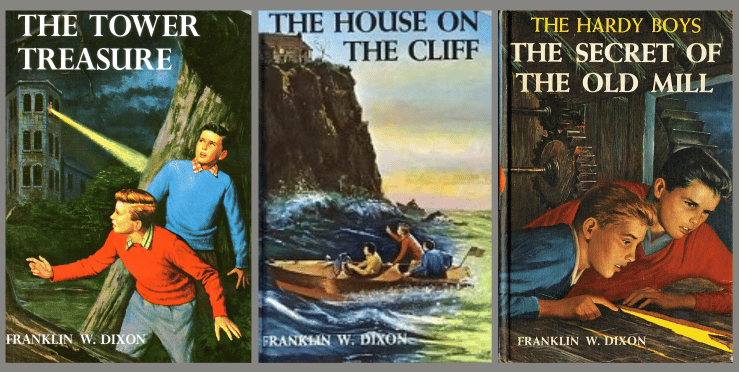
There’s no indication that Hulu’s decision was influenced by the copyright status of The Hardy Boys’ titular characters. But it’s also no secret that under the “cost-plus” model used by streaming services nowadays, the rates paid to producers, talent and rightsholders become more expensive the longer a series goes on. You’d forgive any business-minded licensee for thinking twice about paying escalating fees for the right to use source material that may only be copyrighted within an inch of its life.
NEW—Copyright Lately‘s deep dive on Public Domain Day 2024 is up now!
Happy Public Domain Day 2023
On January 1, 2023, Frank and Joe Hardy will be in good company. That’s when a whole slew of popular books, stories and films first copyrighted in 1927 will enter the public domain in the United States. They include the Hermann Hesse novel Steppenwolf, Virginia Wolff’s To the Lighthouse, and The Case-Book of Sherlock Holmes, which features the final set of Sir Arthur Conan Doyle’s Sherlock Holmes stories (more on that one later).

Also heading to the U.S. public domain on January 1 are the 1927 films The Lodger, which was Alfred Hitchcock’s first thriller, and The Jazz Singer, the first full-length movie to feature synchronized dialogue. Unfortunately, that one is also a racist mess.
And let’s not forget the groundbreaking and highly influential Metropolis, which is actually about to make its second trip into the public domain. The copyright in the Fritz Lang motion picture first lapsed in 1955 after its owner didn’t renew the initial copyright registration. However, in 1996, the Uruguay Rounds Agreements Act resurrected the film’s copyright. The Act restored protection for Metropolis and other foreign works that were still protected by copyright in their source countries, but which had fallen into the U.S. public domain for failure to comply with the various formalities (e.g., notice, registration and renewal) formerly imposed under U.S. law.
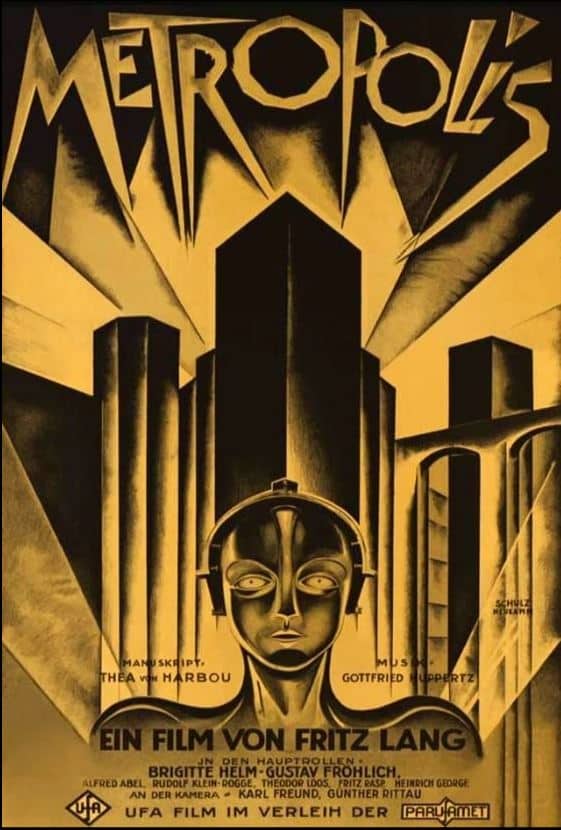
The public domain status of all of these works was further delayed by 1998’s Sonny Bono Copyright Term Extension Act (CTEA), which extended the term of copyright protection for subsisting copyrighted works by 20 years. Works copyrighted prior to 1978 had their terms extended from 75 years to 95 years from the date of publication.
Following a twenty-year hiatus that ended in 2019, a new crop of works has entered the U.S. public domain each year on January 1. In 2023, this will include all works first published in 1927. Note that works remain protected until the end of the calendar year. That’s why Disney’s Steamboat Willie won’t enter the public domain until January 1, 2024, even though the film is set to celebrate its 95th birthday in 2023.
IMPORTANT Public domain is country specific. Just because a work is in the public domain in the United States doesn’t mean it isn’t protected by copyright elsewhere—and vice versa. Check out the Copyright Myth Project for more.
A Matter of Character(s)
One of the most interesting issues involving older content involves characters that first appear in a public domain work but which then evolve or change over the course of later works that are still protected by copyright. For example, the version of Mickey Mouse featured in Steamboat Willie had black eyes, small ears, and a pointy nose. He also had a bad temper and the unfortunate habit of using barnyard animals as musical instruments.
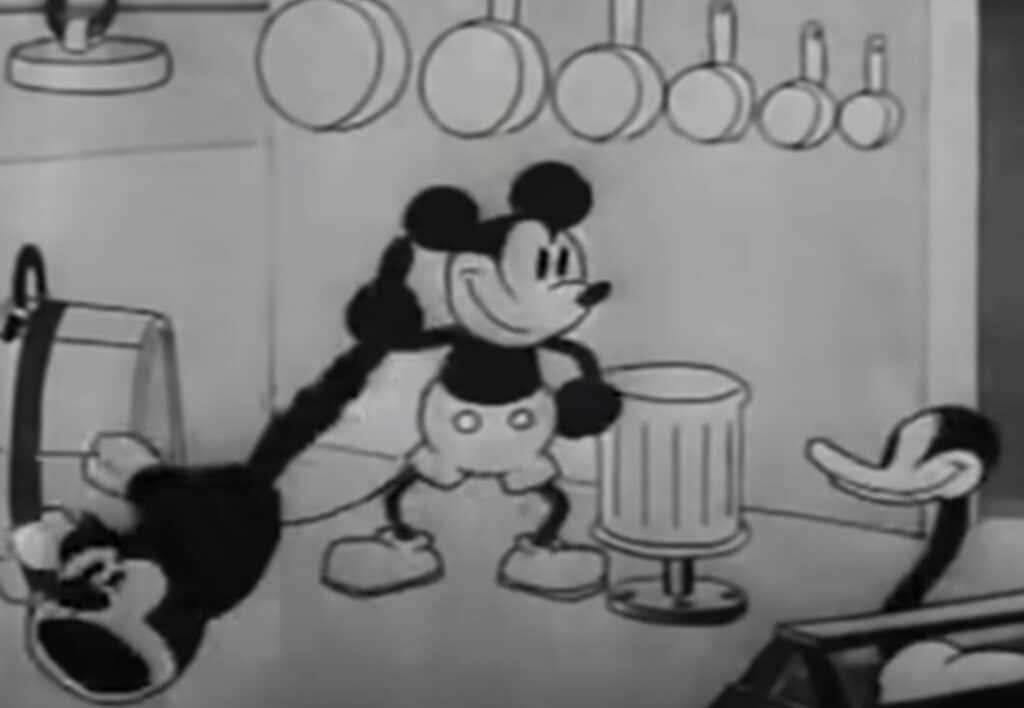
Gradually, over time, Mickey’s eyes were enlarged (and pupils were added), his ears became more pronounced, and his nose was shortened. Following a visit from the ASPCA, he became devoted to animals. These later versions of Mickey will still be protected by copyright even after the character’s original iteration enters the public domain.
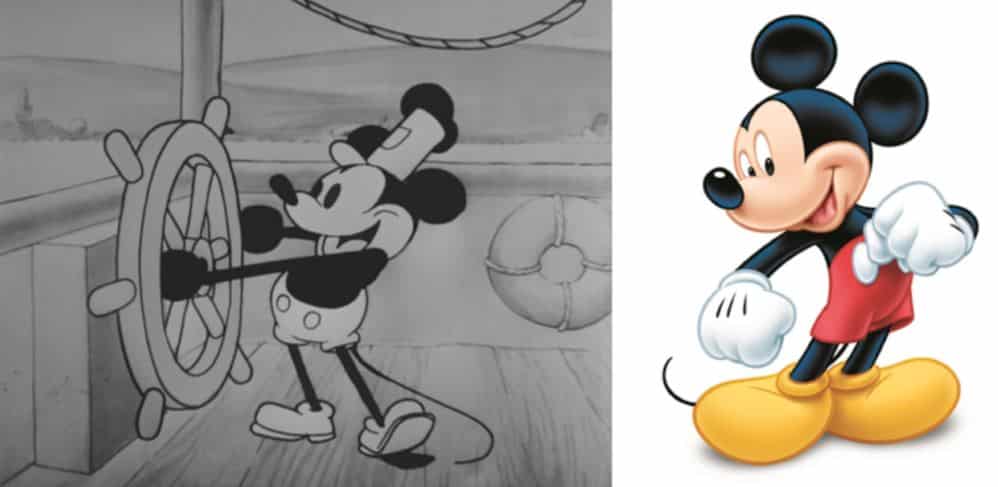
The principle that characters which evolve over time don’t enter the public domain all at once was established by the 2014 opinion in Klinger v. Conan Doyle Estate, Ltd. The Klinger case arose because the Arthur Conan Doyle estate tried to claim that Doyle’s Sherlock Holmes character would stay out of the public domain so long as any individual work depicting the character remained protected. But the Seventh Circuit rejected that view.
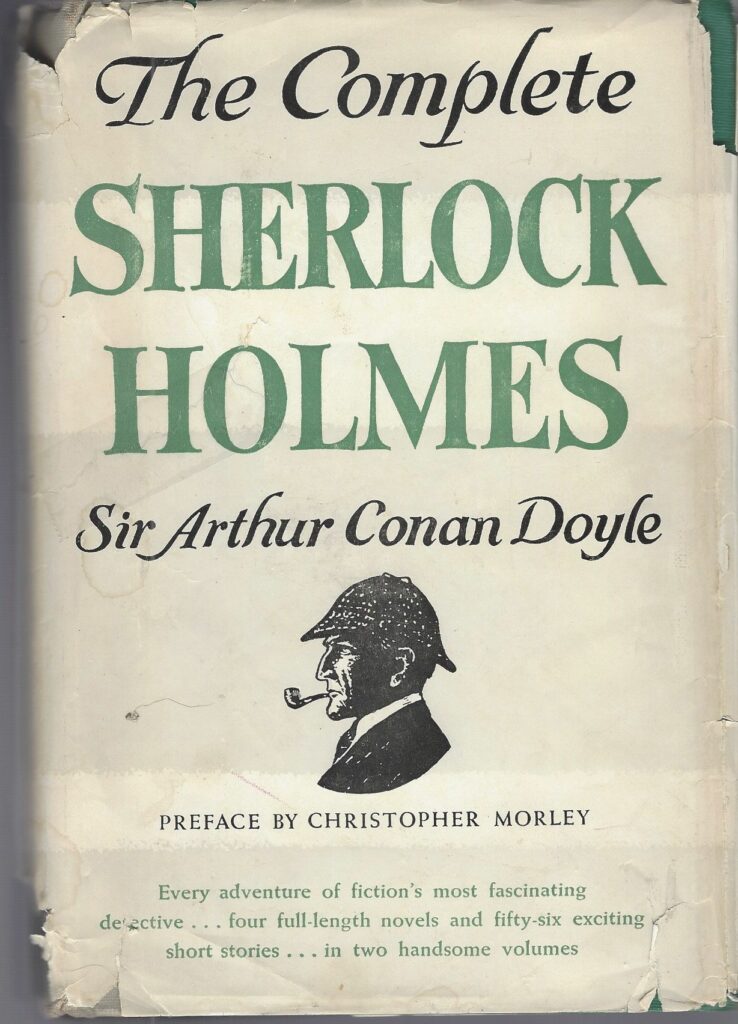
Instead, the court ruled that a copyrighted character begins to fall into the public domain when the first published story featuring that character enters the public domain. At this point, “story elements—including characters covered by the expired copyright—become fair game for follow-on authors.”
At the same time, those aspects of the character’s evolution that don’t appear until later works may still be eligible for copyright protection.
While later iterations of a character may be protected, you can’t bootstrap the copyright in a derivative work to extend protection on the original work. Because author Klinger was only looking to adapt the Holmes and Watson characters as they appeared in the stories that had lapsed into the public domain, he was free to do so.
Still, the fact that fully 98% of the Sherlock Holmes works are in the public domain hasn’t stopped the Doyle estate from taking the position that nearly anyone who wants to create a derivative work featuring the character needs to get a license. Among the licensed works touted on the Estate’s slickly-produced website are the long-running CBS series “Elementary,” the Will Ferrell comedy “Holmes and Watson” and two films starring Robert Downey, Jr. But come January 1, 2023, none of the stories in the original Sherlock Holmes canon will be protected by U.S. copyright.
Running Down the Clock

Estates of famous authors have sometimes tried to enforce their rights in works up until the last minute. The estate of Harold Lloyd provides a good example of a copyright owner attempting to wring every last ounce of copyright protection from a work before the protection clock ran out. Perhaps to underscore the ticking time analogy, in 2014, Harold Lloyd Entertainment filed a lawsuit against the manufacturer of a clock that the plaintiff argued was a “direct appropriation of the iconic clock scene” from Lloyd’s 1923 film “Safety Last.” Harold Lloyd Entertainment filed several lawsuits alleging infringement as late as 2015—92 years after the film’s copyright was originally secured and just a few years before it was set to expire.

Interestingly, were it not for the passage of the CTEA in 1998 (or had the film been released just one year earlier), “Safety Last” would have been in the public domain at the time of the 2014 suit. Instead, it was part of Public Domain Day’s Class of 2019, soon to be joined in January 2023 by another Harold Lloyd classic, “The Kid Brother.”

Extending Rights in Public Domain Works
There are a few recognized methods that publishers and other rightsholders use to retain market share even after a work has entered the public domain. “Special editions” tend to proliferate a year or two before a copyright is set to expire, filled with annotations, prefaces and essays that are still protected by copyright.
For example, Agatha Christie’s estate just authorized the first-ever Miss Marple Calendar as well as twelve new mysteries featuring the character. The estate’s announcement of these works coincides with the first Miss Marple story’s impending entry into the public domain.
Note that the early appearances of the Marple character are different than how she appears in later Agatha Christie books. That’s another reminder to make sure that if you use copyrighted characters featured in a public domain work, you shouldn’t take aspects of those characters that first appear in later works still protected by copyright.
The same is true of Winnie the Pooh. The first collection of Pooh stories entered the public domain in 2022, and Now We Are Six will follow in 2023. But Pooh didn’t appear wearing a red shirt until 1932, and Disney didn’t release its first theatrical short featuring the character until 1966. That version of Winnie the Pooh won’t enter the U.S. public domain until 2061.

Another, more controversial approach involves using trademarks (which can be perpetual) in characters to extend protection in public domain works. The Supreme Court hasn’t ruled on the precise question, although in 2003, Justice Scalia, writing for the Supreme Court in Dastar Corp. v. Twentieth Century Fox, warned that allowing these types of restrictions on a public domain work could effectively create “a species of mutant copyright law” that would limit the public’s right to copy and use expired copyrights.
With the impending entry of the Steamboat Willie version of Mickey Mouse into the public domain in 2024, we may see the interplay between public domain copyrights and perpetual trademarks play out in court pretty soon.
As always, I’d love to hear your thoughts in the comments below or on social media @copyrightlately. I’m now also on Mastodon at copyrightlately@mastodon.social. Meanwhile, here are some notable works that you can copy, distribute or adapt starting on January 1, 2023:
Notable Films Entering the Public Domain in 2023
- Metropolis
- Wings
- Chicago
- London After Midnight
- Sunrise
- The Lodger: A Story of the London Fog
- The Jazz Singer
- The Unknown
- It
- The Great Leap
- The Cat and the Canary
- 7th Heaven
- Underworld
- When Boys Leave Home
- The Beloved Rogue
- The Kid Brother
- The Mystery of the Louvre
- Uncle Tom’s Cabin
- The Way of All Flesh
- Casey at the Bat
- Tarzan and the Golden Lion
Notable Books Entering the Public Domain in 2023
- To the Lighthouse, Virginia Wolff
- Steppenwolf, Hermann Hesse
- Death Comes for the Archbishop, Willa Cather
- The Big Four (Hercule Poirot, #4), Agatha Christie
- The Bridge of San Luis Rey, Thornton Wilder
- Amerika, Franz Kafka
- The Case-Book of Sherlock Holmes, Arthur Conan Doyle
- Now We Are Six (Winnie-the-Pooh, #4), A.A. Milne
- Men Without Women, Ernest Hemingway
- Emily’s Quest (Emily, #3), L.M. Montgomery
- The Tower Treasure (The Hardy Boys, #1), Franklin W. Dixon (pseudonymous)
- The House on the Cliff (The Hardy Boys, #2), Franklin W. Dixon (pseudonymous)
- The Secret of the Old Mill (The Hardy Boys, #3), Franklin W. Dixon (pseudonymous)
- Aspects of the Novel, E.M. Forster
- The Gangs of New York, Herbert Asbury
- The Colour Out of Space, H.P. Lovecraft
- The Treasure of the Sierra Madre, B. Traven
- Twilight Sleep, Edith Warton
- The Tuesday Night Club: A Miss Marple Short Story (Miss Marple), Agatha Christie
- Mosquitoes, William Faulkner
- The Killers, Ernest Hemingway
- Freddy Goes to Florida (Freddy the Pig #1), Walter Rollin Brooks
- In Another Country, Ernest Hemingway
- The Future of an Illusion, Sigmund Freud
- Gentlemen Prefer Blondes / But Gentlemen Marry Brunettes, Anita Loos
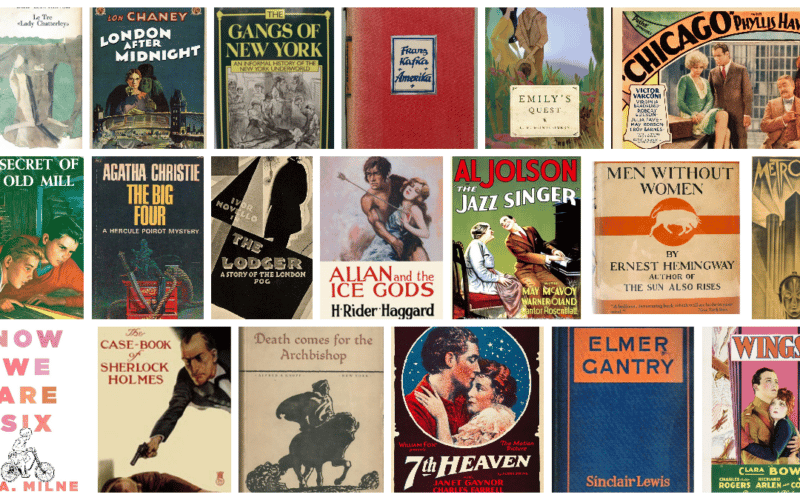




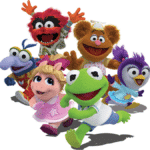

22 comments
Aaron,
Great blog. I imagine many hours go into it. I have two questions:
Could Disney put its hundreds of artists on a project to produce Mickey stills in hundreds of thousands of poses and perspectives and backgrounds, register them as created in 2022-2023, get an additional 95 years on these specific stills, and threaten suit on these (after some program for insuring access by the public at large)?
Better yet, could Disney dedicate an AI program to produce hundreds of millions of such stills?
Best,
Thanks Kelly,
Yes, any new derivative works Disney creates will be protected for 95 years from publication, but the copyright in those works couldn’t be used to “resurrect” any aspects of the character that had already fallen into the public domain. However, as I explained in the article, given the extensive changes made in the Mickey character over the years, Disney will be protected for a long time to come.
Using an AI program to create derivative works is risky, because its an open question as to whether those resulting images may be entitled to copyright protection.
Thanks for the article. I do have another question. I have a dream of drawing children’s comic books and also loved reading the Hardy Boys when I was younger. Could I publish my own versions of these three original novels? (I say, “my own versions” because the original novels of the 20s were biased against minorities and I’d want to change that.) Or would they still be under some sort of trademark? If so, could I get around it by calling them just by their book titles and leaving off the words “Hardy Boys?” I’m a regular person not part of a publishing company so I don’t know how this works. Thank you!
I’m unable to provide specific legal advice, but generally speaking, when the earliest iteration of a character enters the public domain, that particular version of the character may be used, along with any plots and stories that are also in the public domain. The public may create derivative versions of the public domain elements, including by changing those elements, so long as the changes don’t infringe later elements of the work that are still protected by copyright. Titles and character names can generally be used to truthfully identify a work so long as they aren’t used in a way that would suggest any sort of sponsorship or association with the original rightsholders.
Hi Aaron. How is iţ that a “character” can be copyrighted? I would have that the Sherlock Holmes stories themselves could be copyrighted, but not that the characters themselves could be copyrighted. Isn’t that like copyrighting an idea?
Hi Don – great question. Most courts have held that characters that are especially distinctive and which have consistent, identifiable attributes may be entitled to copyright protection separate from any particular work in which they appear. But this protection has its limitations. Once the copyright in the work in which a character appears expires, the character, as depicted in that work, enters the public domain. Where a character appears in a series of works over time and evolves over the course of those works, earlier versions of the character may be in the public domain while later versions remain protected. Thanks for reading!
One of the collections of films I am most excited to see fully entering into the Public Domain are the Oswald The Lucky Rabbit films made by Walt Disney and Ub Iwerks. Most of their films are lost or already in the public domain for a few decades. The Walt Disney Company has active trademarks and has used the Rabbit in Epic Mickey (2010) and made some changes to his personality and introduce new aspects to his character. Nonetheless, I am looking forward to this momentous occasion for all humanity, Public Domain Day!
Actually, Aaron, I believe there has been a precedent regarding trademark law extending copyright protection. Back in the ‘90s I believe Goodtimes home video won a lawsuit regarding Dick Tracy. Goodtimes had come out with the four RKO Dick Tracy films from the 1940s, All of which fell into the public domain at the end of their first 28 year period of copyright. The owners of the Dick Tracy character tried to claim that the underlying character rights were still in force and that even though the films had fallen into the public domain, the character rights were still protected. However, if my memory serves me correctly, Goodtimes was able to show that the first appearance of Dick Tracy (I believe it was in a 1930 Chicago newspaper comics section) had completely fallen into the public domain. I believe that the judge ruled that since the character itself had fallen into the public domain, that no trademark on the character itself was enforceable any longer. You might want to check into this.
Hi Greg – I’m not familiar with the case, and I couldn’t find it on Westlaw. Let me know if you have a cite and I’ll check it out!
The first three Hardy Boys titles going into public domain creates some interesting questions due to their unusual history. As you note ,the first 38 Hardy Boys books were revised/rewritten from 1959 through 1974; the extent of revisions varied with each book, ranging from a few word changes to full replacement of the old text with new text completely unrelated to the old story. In the Tower Treasure and House on the Cliff, the revised texts followed the core elements of the original plots but were much faster paced – Even though the revised stories were about 30 pages shorter than the original texts, the revised books added new action scenes to fill out the new plot. Most of the text was completely rewritten, but heavily edited sections of the original text remain in the new text. Secret of the Old Mill was more heavily than the other two. The setting of the books was updated to the 1960s, and the characters were updated to varying degrees. The original texts were taken out of print at that point, but were readily available in used bookstores, and later on resale sites such as EBAY. The revised books are still in print. The original books are sought out by collectors,
The original texts of the first three titles went into the public domain on January 1, 2023, and several smaller publishers are now offering reprints of these three titles. I have looked at several of these reprints, and in at least two cases, the publishers have reprinted the 1959 text rather than the 1927 text. Others have correctly reprinted the 1927 text. The confusion could result from the publishers being unaware that there were two different versions of the book
From your discussion above, I assume that reprinting the 1927 texts is fair game, but reprinting the 1959 versions without the express approval of the copyright owner (now Simon and Shuster) would constitute copyright infringement, and be subject to appropriate penalties under the law.
Is my understanding correct?
Yep – you’re correct. Publishers that are mistakenly reprinting/selling the 1959 versions are at risk. Thanks for reading!
Hi Aaron, great article. I appreciate this is focused on US public domain, but do you think Metropolis is still protected in the UK/EU under their copyright law? I thought for this movie the copyright would be 70 years from the death of Fritz Lang (as he was a European citizen at time of making the movie), which would push this to 2046 before entering public domain in Europe.
Hi Richard,
Yes, that’s correct – the film will be under copyright in Europe through 2046. Thanks for reading!
Why didn’t I see God’s Trombones by James Weldon Johnson on the public domain list for 2023? The book was published in 1927, copyright renewed in 1954.
Hi Pam,
You’re correct that God’s Trombones is now in the U.S. public domain. My list wasn’t mean to be exhaustive. Thanks so much for reading!
Aaron
Hey can the sound from a movie be copyrighted longer than the movie itself
Hi, not sure what film in particular you’re talking about, but sometimes studios during that time would add synchronized sound to preexisting movies. If so, the derivative version of the film with the sound could be protected longer than the original version.
Thank you that answers my question perfectly. Also I really enjoyed reading this article
THank you for all your time hard work put into gathering this information. It is great value, I really appreciate not being bombarded with ads while trying to read it.That’s a rare find these days. Thanks angain for your time and help.
Hello, gee , as an artist and Autist (diagnosed, sorry but given the flood of PPL trying to nip the “good parts” out of a real disability one better stresses that, sorry)
I am SO MIGHTY glad I found your website today.
Autistic PPL do not enjoy breaking rules, the poor among us cannot afford it either, and as an artist I also wish to respect them. Thank you for your efforts.
AK_Hevonen on Twitter / AK-Hevonen on Redbubble
Do you have any list for games?
I don’t, but it’s a good topic for a future article!